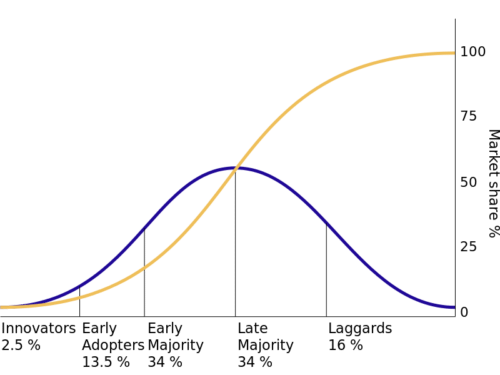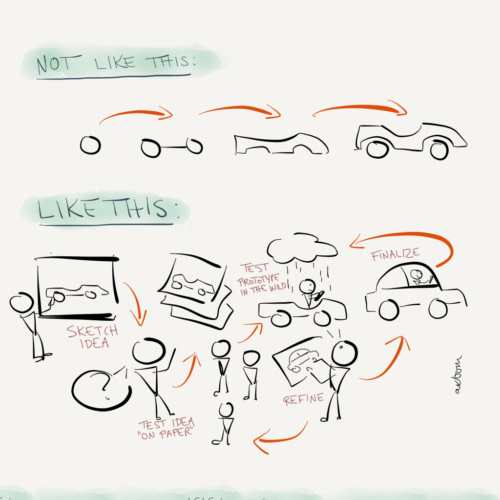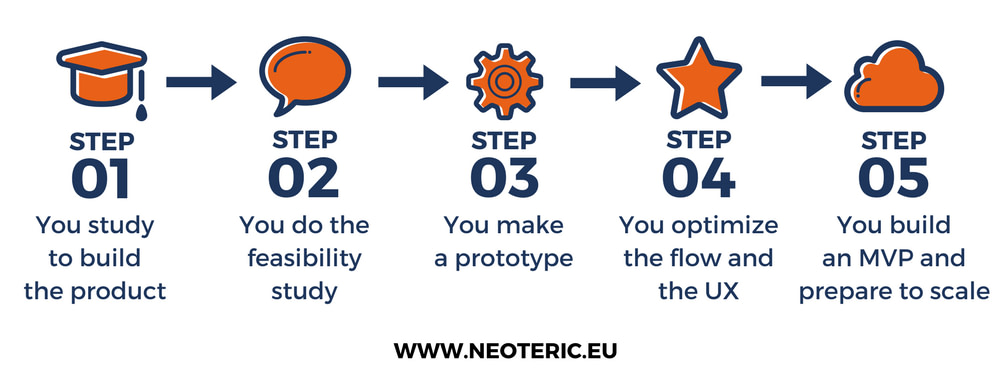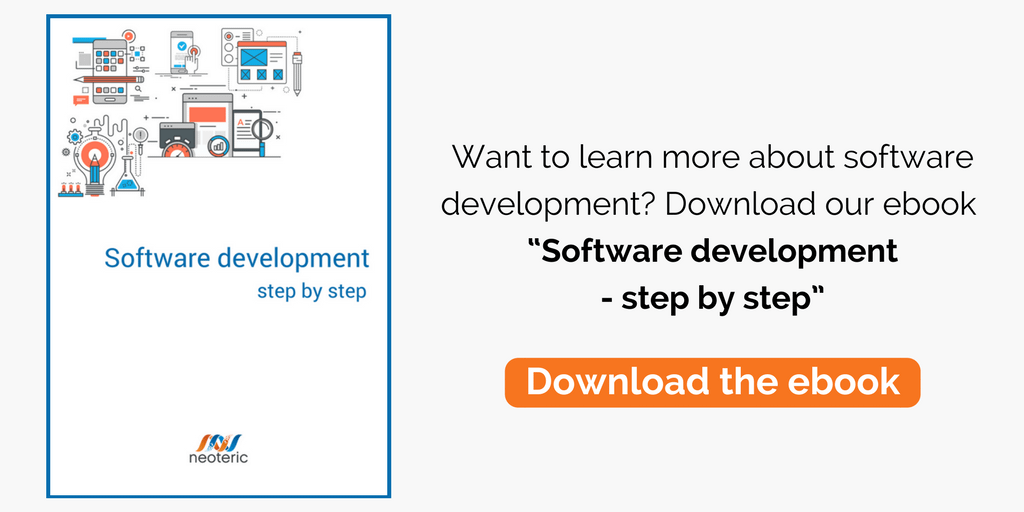I often get questions about product development. Entrepreneurs ask me what an MVP is, how to get to it, or how to find their product market fit. They want to know what some good practices are, what mistakes they can avoid, and what they should focus on at each stage of the development.
Recently, we’ve asked those questions to 10 of the most successful Polish startups who were kind to share their advice on what you should think about before you make an application (btw, if you haven’t read it yet, I recommend you do it). Today, I will continue this topic and tell you how to get to the MVP.
“I have an idea and I want to build an MVP”
First and foremost: don’t start with a minimum viable product. A minimum viable product is when the market decides that your product solves an important problem. It is quite late in the whole product development life cycle. Before there is a feasibility study, there is a proof of concept and there is a prototype. And even though it may be tempting to take a big leap and skip some stage, I highly recommend you: don’t take shortcuts! I can admit to taking some and I can tell you: they never work. They didn’t work for us, either. Instead, they cost us a lot of money and effort and eventually made it harder to succeed.
So, where do we start? I encourage you to start with the feasibility study. Putting it briefly, it is an assessment of the practicality of a proposed project or system. It is when you have an idea and want to check if it’s worth to make it real. Its goal is to find a problem-solution fit.
At the very beginning of your work, it is very important to get in touch with your target group and to ask them the right questions. You need to know:
- What is your customers’ problem?
- How do they solve it?
- How do they approach the new solutions?
- Where do they search for new solutions?
- What kind of opinions matter for them before making a decision?
Once you know that, it’s important to check if your idea is something that they would recognize as a solution to that problem.
“How do I know that I have a problem-solution fit?”
A problem-solution fit is when you have a prototype, which is the simplest version of your product, and you are getting feedback. The product at this stage does not have to be beautiful, have a great design, or an onboarding process. It doesn’t matter if you make enough money from your customers, and it’s not the time to focus on your customer acquisition cost or their lifetime value. The first currency you get is feedback. That’s right: not money, but feedback. And not only from your customers but also from influencers, from experts in the field – from people who know about the vertical you’re trying to get into.
How to collect this feedback? Actually, there are many ways of doing it – it doesn’t have to be a traditional survey. You can test if customers find your idea feasible for them by creating a landing page, driving traffic to it and observing how they behave. How much time do they spend there? Are they interested enough to leave their e-mail to get notified when the beta version is ready? Are they willing to share their thoughts for the promise of getting the solution faster or cheaper than the others? Would it be worth for them to get this solution?
Don’t be afraid of talking about your idea, because this is the way you get feedback. Every information you get at this stage is priceless. And you should listen to the users carefully as they might tell you things you’ve never even thought of. Feedback is extreme valuable and it should never be underestimated. After all, it brings you closer to building a product that actually answers the users’ needs.
Read also: Software Development Life Cycle
Diffusion of innovations
According to the diffusion of innovations theory, there are 5 types of customers: innovators, early adopters, early majority, late majority, and laggards.

Innovators
This is the smallest group and the group you should target first. These are the people who are constantly looking for a new way of solving problems, who are ready to overcome some early days problems before your product gets mature and out of bugs. They are the most active, the most forgiving, and the most willing to share feedback.
Early adopters
Just like the innovators, they want to experiment, they want to make their lives easier, they want to find better solutions to their problems. Unlike the innovators, they don’t have the time or the urge to test every new solution that comes out, and so they need testimonials to get interested. Once they are referred that there is an interesting new thing out there, they will want this product, and they will still forgive more than the majority of users from the other groups.
Early majority
These are the ones who buy a product when it’s released to the public and when they can read its reviews. They watch innovators and early adopters, they are willing to take a chance with a new product, but they are not willing to take a risk and test the new thing themselves. Instead, they are waiting for a signal that it proves to be successful in practice. It’s one of the biggest segments of users, but you shouldn’t target them before having an MVP.
Late majority
They buy a new product when it’s not that new anymore. They are not swayed by advertising, they are not tempted by the exclusiveness of the new solution, and they will not forgive the bugs. They make a purchase decision only after seeing other people using the product and getting recommendations.
Laggards
Those who are always behind the market. They don’t like changes, they don’t adopt the innovations, and they try new things only when they have no other choice. They strongly base on the opinions of their friends and family, and they believe that the innovations presented on TV are “not for them”. If you are at an early stage of your product’s development, it’s a long way before they purchase your product.
Finding the right target
There are five types of customers and it is extremely important to address your message to the right people at the right stage of your product’s development. Taking a shortcut, trying to reach the majority of your long-term target group at the early stage may burn your budget and not bring satisfactory results.
To see a good example of how to attract the right people at the right stage, let’s move to a different sector for a while and take a look at the automotive:
They don’t just produce a car and put it on the market. They start by releasing early sketches. There are the newspapers and portals for fans, there are programs like Top Gear, where they get prototypes, they exhibit at trade shows, they write about it. And when the idea gets enough attention… they don’t release the product. They test technical nuances in places like Formula 1, they are experimenting doing the R&D and constantly learning what their users value most.
After showing off the trades, getting enough attention to the product, and after testing the prototype, they eventually create an MVP. And as it’s a MINIMUM version of the intended product, it’s just the hatchback, with 3 types of engine and 5 different colors. They go to the market when they have the best recognition and look if they get the numbers right. If they do, if they get the conversions right, if they get enough attention, and if they get enough traction – they upgrade to a fully featured product. Now it has 10 different engines, multiple car body configurations, hundreds of different colors, and millions of different combinations of how can you customize the product. And then they run huge campaigns to reach as many people as possible.

(source: http://uxpodcast.com/89-mvp-russ-unger-stephen-anderson-jeff-gothelf/)
There are at least two things that we can learn from the automotive:
The first is to reach the audience in the right order – starting with the innovators followed by the early adopters who are willing to test the idea, through the early majority to the late majority.
The second is not to be obsessed with the features. First, validate your idea: go out, get to the customers, talk and collect feedback.
Reaching the right audience at the very beginning will help you go to the market in a valuable and profitable way. Get attention, gather opinions, calculate your customer acquisition cost, start anticipating your customer lifetime value and prepare to scale. If you have a solution that is 10x better than what a customer is currently using – you’re on a good way.
To sum it up: Your first goal is to get to the innovators in your vertical and validate your idea – based on survey, mockups, sketches, storyboards, presentations, or landing pages where you can ask people to sign up – to get notified when you have an alpha version, to get an invitation (remember Gmail in 2004? Only ~1000 people were invited to participate in testing its beta version!), to make it viral, to build a community around your idea.
Prototype
Ok. So you’ve done the feasibility study. You understand your customers, you know their pains and gains, you’ve found a problem-solution fit. You’ve created your first proof of concept and you’ve collected a great feedback. People got interested in your idea and they are waiting for the prototype. Congratulations! Now it’s time to build a prototype.
Just like in the case of automotive, it’s not the product you actually want to build. It doesn’t have to be beautiful, have a great design, or an onboarding process. Technology also does not matter yet. What matter is how is how your solution changes the lives or businesses of your customers, what impact does it have, and if the gains you offer are bigger than what you are asking for (time, effort, cash).
Don’t get into all of the push notifications, different frameworks for notifying users, onboarding sessions, integrations, new customization options, and all the other extra features that are supplementary to the core value you give but take a lot of time. You will get there later. Right now, you focus on growing the buzz and giving the innovators the simplest and the fastest way to discover your product. And to get the “Aha” moment.
The “Aha” moment is when your users can recognize the value brought by your product. It’s when they discover that it actually helps them solve their problem and makes their life easier – when they realize that they can order the food without searching the restaurant and making a phone call, that they can easily share large files, or that they can schedule a meeting without sending back-and-forth emails to set up a date. Especially in the early days, you need to think of getting your users from the first contact with your brand to the magic moment in the easiest and fastest way – this is your goal. And this is when more and more users are willing to try your solution.
My advice for this phase: fight one customer after another. Acquire them, ask for feedback, optimize the way you get the user to the magic moment, optimize the onboarding process.

Key Takeaways:
- The first and foremost goal when you’re thinking about making an app is to find a way of solving your customers’ problem 10 times better compared to what is his first choice as a solution.
- Get to the most innovative users in your vertical or to the most innovative vertical – if your product is horizontal.
- Treat feedback as the most valued currency, especially in the early days. Before you start the development, ask people about your idea – show your sketches, show your prototypes, build a proof of concept and monitor the traction.
- If you want to get to the MVP, you need to find product market fit – to do that, you need to make enough attention on the market. And to build a recognition that your product solves the problem 10x better than the regular first-choice solution.
- Building a product using MVP does not mean that you can omit feasibility study or a proof of concept.
- Remember that at the early stage, your users are putting more than their license money: they’re putting their time into learning your product, into using your product. Make sure that it’s worth it! Focus on delivering value to the end user and make sure that he gets 10 times more than he puts in.

